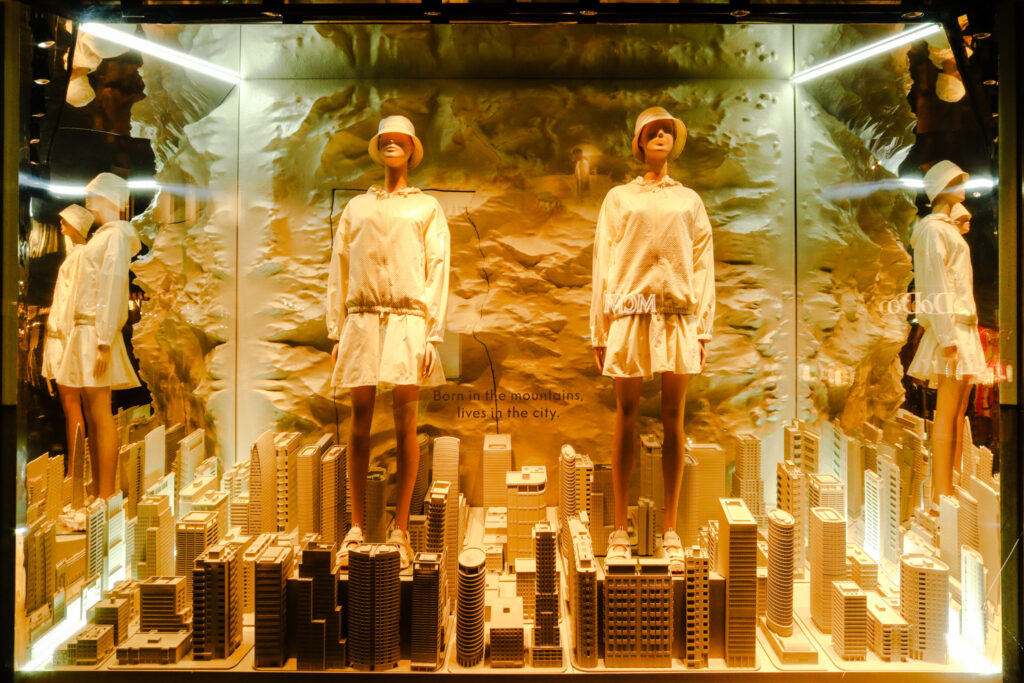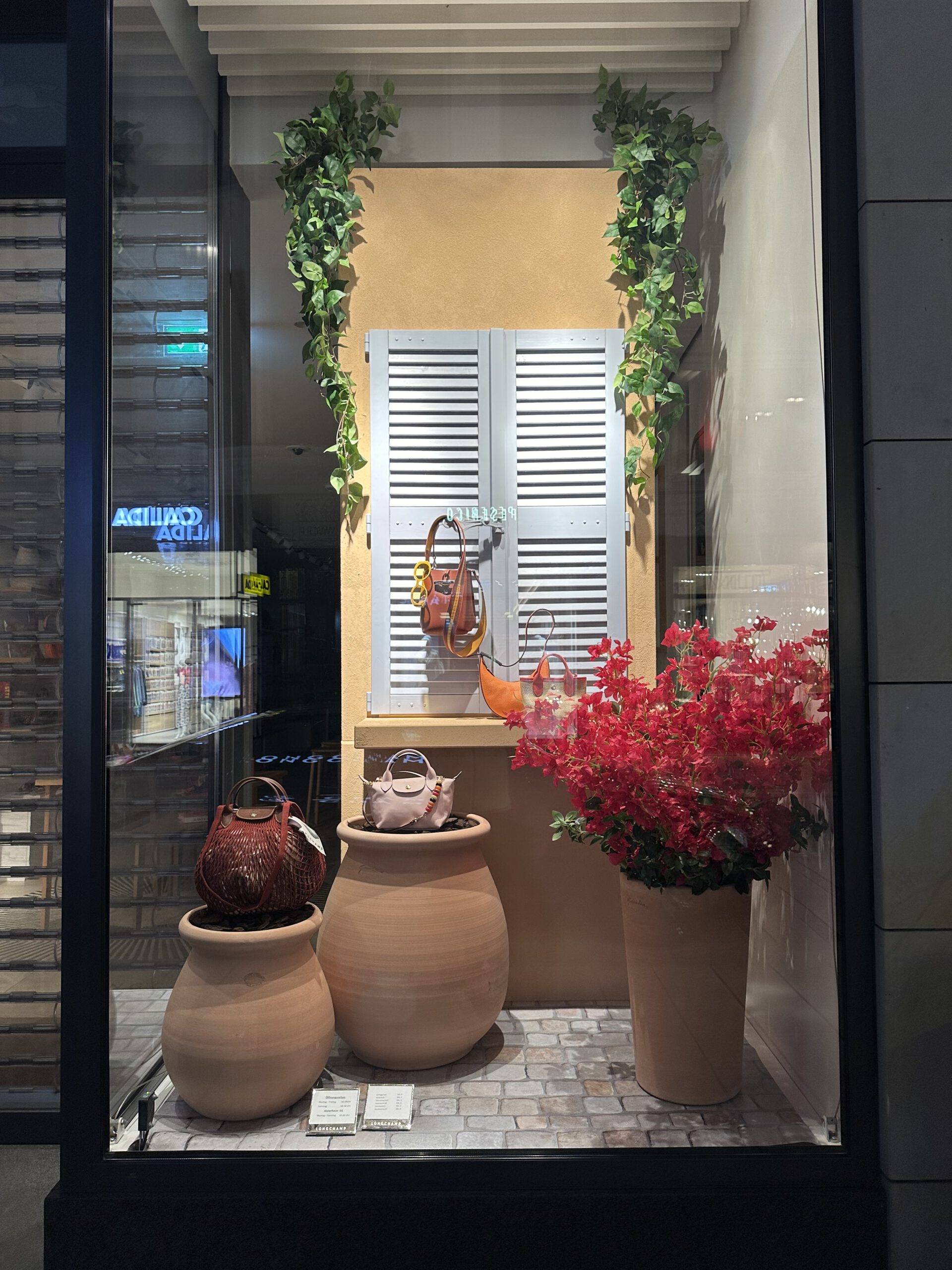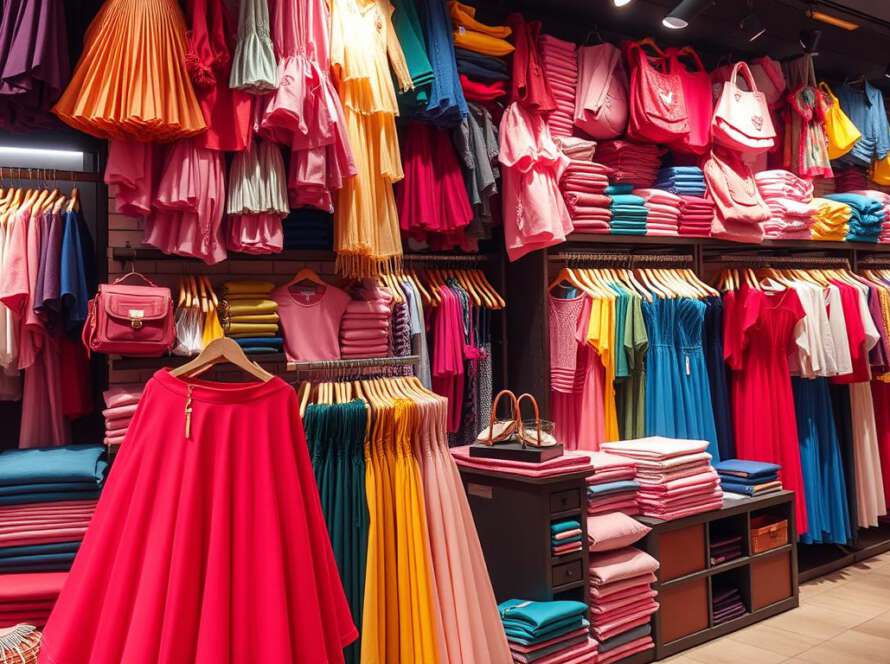In today’s competitive retail world, making a good first impression is key. Visual merchandising is vital, especially through eye-catching storefronts. It helps improve sales by focusing on effective retail strategies.
This article will cover various techniques like color theory, lighting, and seasonal displays. We’ll see how these elements make storefronts appealing to customers. Let’s explore the world of visual merchandising and its role in engaging customers.
Key Takeaways
- Visual merchandising is crucial for capturing potential customers’ attention.
- Effective storefronts significantly enhance retail strategy for better sales improvement.
- Color theory and lighting are vital design principles for creating attractive storefronts.
- Seasonal and thematic displays can engage customers and boost interest.
- Incorporating technology enhances customer interaction and engagement.

Understanding Visual Merchandising
Visual merchandising is key in retail. It makes shopping better by arranging products in a way that invites customers in. It’s a mix of art and science that makes products look appealing and encourages people to buy.
The Role of Visual Merchandising in Retail
In retail, visual merchandising changes how shoppers act and feel. It shapes our first impression of a brand. Good merchandising makes a store feel welcoming, building loyalty and improving the shopping experience.
Key Elements of an Effective Visual Merchandising Strategy
Several important parts make up a good visual merchandising plan. These include:
- Layout design: A well-planned store layout helps customers move easily, making shopping better.
- Product placement: Placing items in smart spots can lead to more sales, especially for promotions or top sellers.
- Promotional displays: Catchy displays and signs grab attention, drawing in more customers and increasing sales.
Combining these elements creates a strong visual merchandising strategy. It grabs our attention and improves the shopping experience, key for success in today’s market.
Why Storefronts Matter
Storefronts are key in the retail world. They are the first thing people see when they think of our brand. A good storefront grabs attention and invites people to come in.
It shows what we offer and makes people curious. A well-designed storefront can really stand out and draw in customers.
The Impact of First Impressions on Shopping Behavior
First impressions are crucial. They decide if someone will go into a store or keep walking. Studies show people make up their minds quickly about a storefront.
By making our storefronts look good and welcoming, we increase the chance of attracting customers. A nice storefront makes people feel welcome and valued before they even enter.
How Storefronts Reflect Brand Identity
Our storefront is a way to show who we are. We choose colors, materials, and signs that match our values and message. This makes our brand look consistent and trustworthy.
When customers see our storefront, they feel a connection. This connection builds trust and loyalty. It shows our brand’s personality and values.
| Element | Impact on First Impressions | Brand Identity Reflection |
|---|---|---|
| Color Scheme | Evokes emotions and attracts attention | Communicates brand personality (e.g., vibrant for energy, muted for sophistication) |
| Signage | Provides clarity and creates a welcoming atmosphere | Defines the brand’s message and style |
| Display Arrangement | Guides foot traffic and highlights key products | Showcases creativity and brand innovation |
| Lighting | Enhances visual appeal and draws the eye | Sets the mood consistent with brand ethos |
Design Principles for Attractive Storefronts
Creating an appealing storefront is all about design principles. We focus on color theory and ambiance lighting to make a strong visual impact. This makes our storefront inviting and showcases our products well.
Color Theory and Its Role in Attracting Attention
Color is key in design. It can make people feel certain ways. Warm colors like red and yellow make us excited. Cool colors like blue and green calm us down.
Knowing color theory helps us pick the right colors for our brand. This attracts the right customers for us.
Utilizing Lighting to Create Ambiance and Highlight Products
Good lighting makes a storefront stand out. The right light placement can make a space feel welcoming. It encourages people to look around.
We use special lighting to highlight important products. Mixing natural and artificial light makes things look better. It also guides customers to what we want them to see.
| Color | Emotion Evoked | Use in Storefront |
|---|---|---|
| Red | Excitement, Urgency | Sale Promotions |
| Blue | Trust, Calm | Corporate Branding |
| Yellow | Happiness, Attention | Seasonal Displays |
| Green | Growth, Renewal | Eco-Friendly Products |
Understanding color and lighting helps us make storefronts that grab attention. They also leave a lasting impression on customers.
Visual Merchandising: How Importance the Storefronts in Attracting Customers and
Storefronts are key in visual merchandising. They act as silent salespeople. About 70% of purchases are influenced by what they see first. This shows how important storefronts are in drawing in customers.
A good storefront is not just about looks. It’s also about how it works. Things like signs, displays, and colors make shopping better. These elements not only attract people but also make a good first impression, leading to loyal customers.
“Your storefront is your first opportunity to speak with potential customers. Make it count!”
To make your storefront better, try these steps:
- Update displays to match current trends and seasons.
- Use bright colors and creative layouts to grab attention.
- Put up clear and attractive signs to guide people.
- Show off your brand’s identity to stand out.
- Make sure customers can see important products easily.
Let’s look at how good storefronts compare to bad ones:
| Store Type | Foot Traffic Increase (%) | Customer Retention Rate (%) |
|---|---|---|
| Stores with Engaging Storefronts | 45 | 80 |
| Stores with Unattractive Storefronts | 10 | 30 |
This shows that good visual merchandising is linked to better storefronts. By improving their storefronts, stores can make a welcoming space. This encourages people to come in and look around.
Seasonal and Thematic Displays
To make shopping exciting, we need to change our storefronts for each season. By using holiday-themed merchandising, we can draw in more shoppers. These displays not only show off products but also make shopping fun.
Adjusting Your Storefront for Holidays and Events
Seasonal displays capture the holiday spirit. As holidays come, we update our storefronts to match the theme. This might include:
- Using festive colors and decorations that reflect the holiday vibe.
- Incorporating seasonal products that entice shoppers.
- Arranging displays to facilitate easy navigation and highlight promotional items.
These changes help attract more people and keep them longer. They enjoy exploring our themed environment.
The Benefits of Storytelling in Visual Merchandising
Storytelling in retail makes shopping personal. It adds depth to our seasonal displays. We can tell stories through:
- Creating scenes that represent holiday traditions and celebrations.
- Featuring products that tie into the stories we tell, making them more relatable.
- Utilizing signage that explains the theme or historical significance behind the display.
By engaging in storytelling and thoughtful merchandising, we build emotional connections. This leads to more loyalty and sales.
| Season/Event | Suggested Theme | Key Elements |
|---|---|---|
| Winter Holidays | Winter Wonderland | Snowflakes, warm colors, holiday lights, gift displays |
| Spring | Floral Festivity | Pastel colors, flowers, seasonal clothing, outdoor themes |
| Summer | Beach Vibes | Sand, beach balls, summer apparel, outdoor accessories |
| Fall | Harvest Celebration | Warm earth tones, pumpkins, fall cooking items, back-to-school supplies |
Incorporating Technology in Visual Merchandising
Technology is changing retail fast. Using digital displays can make our stores stand out. These displays grab customers’ attention and help us connect with them better.
With dynamic visuals, we can make shopping memorable. This way, customers remember our brand more.
How Digital Displays Enhance Customer Engagement
Digital displays are key in today’s fast world. They include interactive screens, video walls, and augmented reality. These features let customers explore products in a fun way.
As they play with our displays, their shopping experience gets better. We encourage them to learn more about what we offer.
The Use of Social Media to Promote Storefronts
Social media is vital for bringing people to our stores. We show off our digital displays and unique ideas on Instagram and Facebook. This creates excitement and invites people to share their experiences.
When customers post about us online, more people see our store. This boosts our visibility and brings in more visitors. Using social media with in-store tech makes our brand more engaging for everyone.
Case Studies of Successful Storefronts
Looking at successful storefronts gives us great insights. We learn about the best ways to display products. We see how top brands draw in customers and keep them engaged.
Analyzing Brands That Get It Right
Apple is a great example. Their simple design shows off products and creates a special atmosphere. Nike, meanwhile, draws people in with interactive displays. These brands use a clear brand analysis to match their look with their values.
What We Can Learn From Their Strategies
Successful storefronts teach us a few key lessons:
- Target Audience Understanding: Showing visuals that match the customer’s interests makes them more engaged.
- Seasonal Adaptation: Changing displays for holidays makes them more relevant and boosts sales.
- Storytelling: Using stories in merchandise pulls customers in on an emotional level.
- Consistent Branding: Keeping the brand look the same everywhere builds recognition and loyalty.
Reflecting on these strategies shows us the power of good visual merchandising. It can create real connections with customers and increase sales. Each brand’s success story shows how innovative storefronts can change the retail experience.
Challenges in Visual Merchandising
Visual merchandising comes with its own set of challenges. Retailers face obstacles in designing storefronts and keeping up with consumer trends. With strategic planning, we can overcome these hurdles and improve our merchandising efforts.
Overcoming Common Obstacles in Storefront Design
Budget limits often hinder our ability to bring visual merchandising ideas to life. With fewer resources, we might struggle to create eye-catching storefronts. However, we can find affordable solutions and train our teams to overcome these challenges.
Adapting to Consumer Trends and Preferences
Consumer trends are always changing, making it essential to stay updated. By analyzing data, we can adjust our merchandising plans to stay relevant. Knowing what our customers like helps us design impactful storefronts. Using surveys and feedback mechanisms helps us connect with our audience and meet their needs.
| Challenge | Potential Solution |
|---|---|
| Budget Constraints | Explore cost-effective materials and design methods |
| Consumer Preferences | Conduct regular market research and surveys |
| Competition | Differentiate our brand by telling a unique story |
| Technology Integration | Invest in training for staff on emerging technology trends |
Conclusion
Our journey through visual merchandising shows how key effective storefront strategies are. A well-designed storefront does more than grab attention. It builds a connection with potential customers.
By focusing on color, lighting, and seasonal displays, we can make a big impact. This creates lasting impressions on everyone who sees it.
As we move forward, it’s important to keep up with changing consumer tastes and market trends. We need to innovate in our visual merchandising. This way, we can attract shoppers and keep them coming back.
In short, a thoughtful approach to storefront design is crucial for retail success. Let’s be creative and flexible. Let’s keep rethinking our strategies to make engaging storefronts that connect with our audience and build brand loyalty.



